
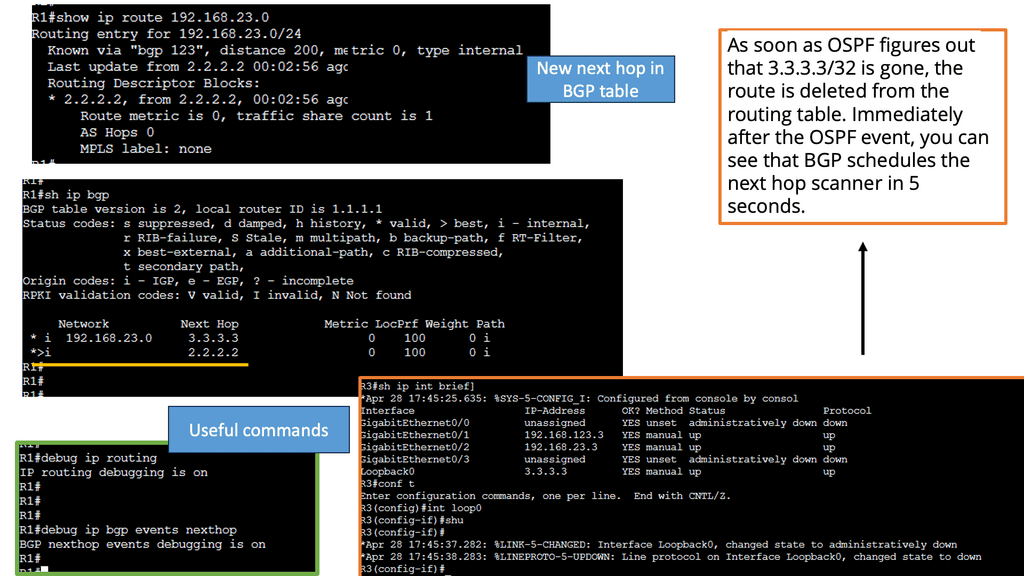
Routing convergence, a critical aspect of network performance, refers to the process of network routers exchanging information to update their routing tables in the event of network changes. It ensures efficient and reliable data transmission, minimizing disruptions and optimizing network performance. In this blog post, we will delve into the intricacies of routing convergence, exploring its importance, challenges, and best practices.
Routing convergence refers to the process by which a network's routing tables reach a consistent and stable state after making changes. It ensures that all routers within a network have up-to-date information about the available paths and can make efficient routing decisions.
When a change occurs in a network, such as a link failure or the addition of a new router, routing convergence is necessary to update the routing tables and ensure that packets are delivered correctly. The goal is to minimize the time it takes for all routers in the network to converge and resume normal routing operations.
Several mechanisms and protocols contribute to routing convergence. One of the critical components is the exchange of routing information between routers. This can be done through protocols such as Routing Information Protocol (RIP), Open Shortest Path First (OSPF), or Border Gateway Protocol (BGP).
Matt ConranWhat is router convergence?
Router convergence means they have the same topological information about the network they operate. To converge, a set of routers must have collected all topology information from each other using the routing protocol implemented. For this information to be accurate, it must reflect the current state of the network and not contradict other routers’ topology information. All routers agree upon the topology of a converged network. For dynamic routing to work, a set of routers must be able to communicate with each other. All Interior Gateway Protocols depend on convergence. An autonomous system in operation is usually converged or convergent. Exterior Gateway Routing Protocol BGP rarely converges due to the size of the Internet.
Convergence Process
Each router in a routing protocol attempts to exchange topology information about the network. The extent, method, and type of information exchanged between routing protocols, such as BGP4, OSPF, and RIP, differs. A routing protocol convergence occurs once all routing protocol-specific information has been distributed to all routers. In the event of a routing table change in the network, convergence will be temporarily broken until the change has been successfully communicated to all routers.
Example: The convergence process
During the convergence process, routers exchange information about the network’s topology. Based on this information, they update their routing tables and calculate the most efficient paths to reach destination networks. This process continues until all routers have consistent and accurate routing tables.
The convergence time can vary depending on the size and complexity of the network and the routing protocols used. Convergence can happen relatively quickly in smaller networks, while more extensive networks may take longer to achieve convergence.
Network administrators can employ various strategies to optimize routing convergence. These include implementing fast convergence protocols, such as OSPF’s Fast Hello and Bidirectional Forwarding Detection (BFD), which minimize the time it takes to detect and respond to network changes.
Mechanisms for Achieving Routing Convergence:
1. Routing Protocols:
– Link-State Protocols: OSPF (Open Shortest Path First) and IS-IS (Intermediate System to Intermediate System) are examples of link-state protocols. They use flooding techniques to exchange information about network topology, allowing routers to calculate the shortest path to each destination.
– Distance-Vector Protocols: RIP (Routing Information Protocol) and EIGRP (Enhanced Interior Gateway Routing Protocol) are distance-vector protocols that use iterative algorithms to determine the best path based on distance metrics.
2. Fast Convergence Techniques:
– Triggered Updates: When a change occurs in network topology, routers immediately send updates to inform other routers about the change, reducing the convergence time.
– Route Flapping Detection: Route flapping occurs when a network route repeatedly becomes available and unavailable. By detecting and suppressing flapping routes, convergence time can be significantly improved.
– Convergence Optimization: Techniques like unequal-cost load balancing and route summarization help optimize routing convergence by distributing traffic across multiple paths and reducing the size of routing tables.
3. Redundancy and Resilience:
– Redundant Links: Multiple physical connections between routers increase network reliability and provide alternate paths in case of link failures.
– Virtual Router Redundancy Protocol (VRRP): VRRP allows multiple routers to act as a single virtual router, ensuring seamless failover in case of a primary router failure.
– Multi-Protocol Label Switching (MPLS): MPLS technology offers fast rerouting capabilities, enabling quick convergence in case of link or node failures.
Strategies for Achieving Optimal Routing Convergence
a. Enhanced Link-State Routing Protocol (EIGRP): EIGRP is a dynamic routing protocol that utilizes a Diffusing Update Algorithm (DUAL) to achieve fast convergence. By maintaining a backup route in case of link failures and employing triggered updates, EIGRP significantly reduces the time required for routing tables to converge.
b. Optimizing Routing Metrics: Carefully configuring routing metrics, such as bandwidth, delay, and reliability, can help achieve faster convergence. Assigning appropriate weights to these metrics ensures that routers quickly select the most efficient paths, leading to improved convergence times.
c. Implementing Route Summarization: Route summarization involves aggregating multiple network routes into a single summarized route. This technique reduces the size of routing tables and minimizes the complexity of route calculations, resulting in faster converge
BGP Next Hop Tracking
BGP next hop refers to the IP address of the next router in the path towards a destination network. It serves as crucial information for routers to make forwarding decisions. Typically, BGP relies on the reachability of the next hop to determine the best path. However, various factors can affect this reachability, including link failures, network congestion, or misconfigurations. This is where BGP next hop tracking comes into play.
By incorporating next hop tracking into BGP, network administrators gain valuable insights into the reachability status of next hops. This information enables more informed decision-making regarding routing policies and traffic engineering. With real-time tracking, administrators can dynamically adjust routing paths based on the availability and quality of next hops, leading to improved network performance and reliability.


Benefits of Efficient Routing Convergence:
1. Improved Network Performance: Efficient routing convergence reduces network congestion, latency, and packet loss, improving overall network performance.
2. Enhanced Reliability: Routing convergence ensures uninterrupted communication and minimizes downtime by quickly adapting to changes in network conditions.
3. Scalability: Proper routing convergence techniques facilitate network expansion and accommodate increased traffic demands without sacrificing performance or reliability.
Example Technology: BFD
Bidirectional Forwarding Detection (BFD) is a lightweight protocol designed to detect failures in communication paths between routers or switches. It operates independently of the routing protocols and detects rapid failure by utilizing fast packet exchanges. Unlike traditional methods like hello packets, BFD offers sub-second detection, allowing quicker convergence and network stability. BFD is pivotal in achieving fast routing convergence, providing real-time detection, and facilitating swift rerouting decisions.
-Enhanced Network Resilience: By swiftly detecting link failures, BFD enables routers to act immediately, rerouting traffic through alternate paths. This proactive approach ensures minimal disruption and enhances network resilience, especially in environments where redundancy is critical.
-Reduced Convergence Time: BFD’s ability to detect failures within milliseconds significantly reduces the time required for converging routing protocols. This translates into improved network responsiveness, reduced packet loss, and enhanced user experience.
-Scalability and Flexibility: BFD can be implemented across various network topologies and routing protocols, making it a versatile solution. Whether a small enterprise network or a large-scale service provider environment, BFD adapts seamlessly, providing consistent performance and stability.
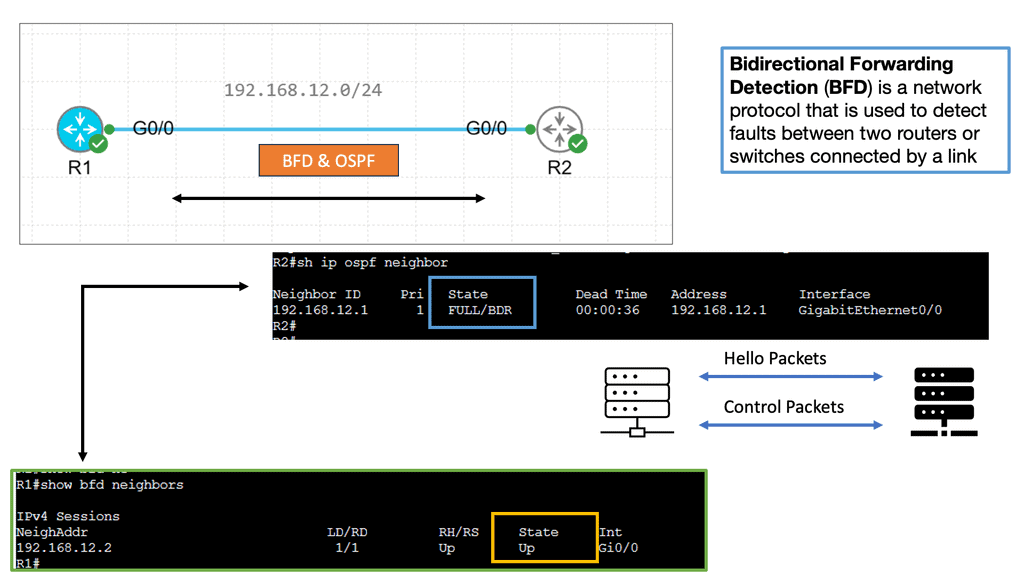
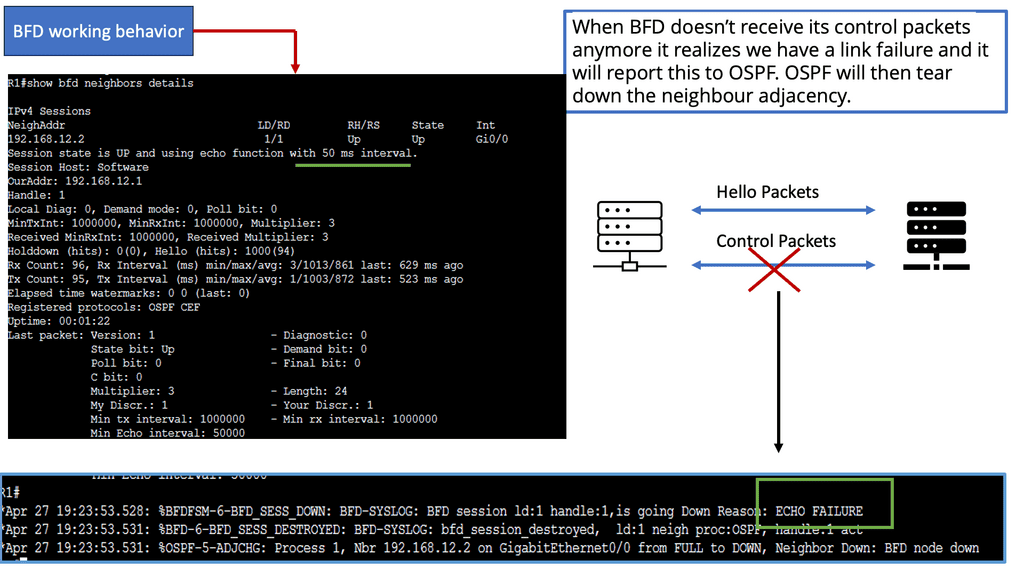
Convergence Time
Convergence time measures the speed at which a group of routers converges. Fast and reliable convergent routers are a significant performance indicator for routing protocols. The size of the network is also essential. A more extensive network will converge more slowly than a smaller one.
When a few routers are connected to RIP, a routing protocol that converges slowly, it can take several minutes for the network to converge. A triggered update for a new route can speed up RIP’s convergence, but a hold-down timer will slow flushing an existing route. OSPF is an example of a fast-convergence routing protocol. It is impossible to limit the speed at which OSPF routers can converge.
Unless specific hardware and configuration conditions are met, networks can never converge. “Flapping” interfaces (ones that frequently change between “up” and “down”) propagate conflicting information throughout the network, so routers cannot agree on the current state. Route aggregation can deprive certain parts of a network of detailed routing information, resulting in faster convergence of topological information.
Topological information
A set of routers in a network share the same topological information during convergence or routing convergence. Routing protocols exchange topology information between routers in a network. Routers in a network receive routing information when convergence is reached. Therefore, all routers know the network topology and optimal route in a converged network. Any change in the network – for example, the failure of a device – affects convergence until all routers are informed of the change. The convergence time in a network is the time it takes for routers to achieve convergence after a topology change. In high-performance service provider networks, sensitive applications are run that require fast failover in case of failures. Several factors determine a network’s convergence rate:
Understanding UDLD
UDLD, at its core, is a layer 2 protocol designed to detect and mitigate unidirectional links in Ethernet connections. It actively monitors the link status, allowing network devices to promptly detect and address potential issues. By verifying the bidirectional communication between neighboring devices, UDLD acts as a guardian, preventing one-way communication breakdowns.
Implementing UDLD brings forth numerous advantages for network administrators and organizations alike. Firstly, it enhances network reliability by identifying and resolving unidirectional link failures that could otherwise lead to data loss and network disruptions. Secondly, UDLD helps troubleshoot by providing valuable insights into link quality and integrity. This proactive approach aids in reducing downtime and improving overall network performance.
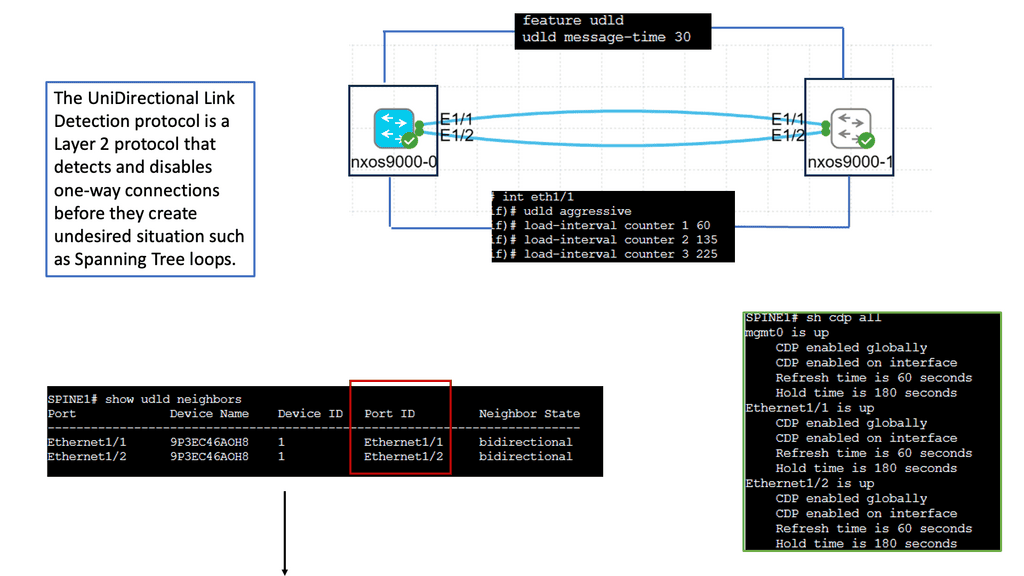
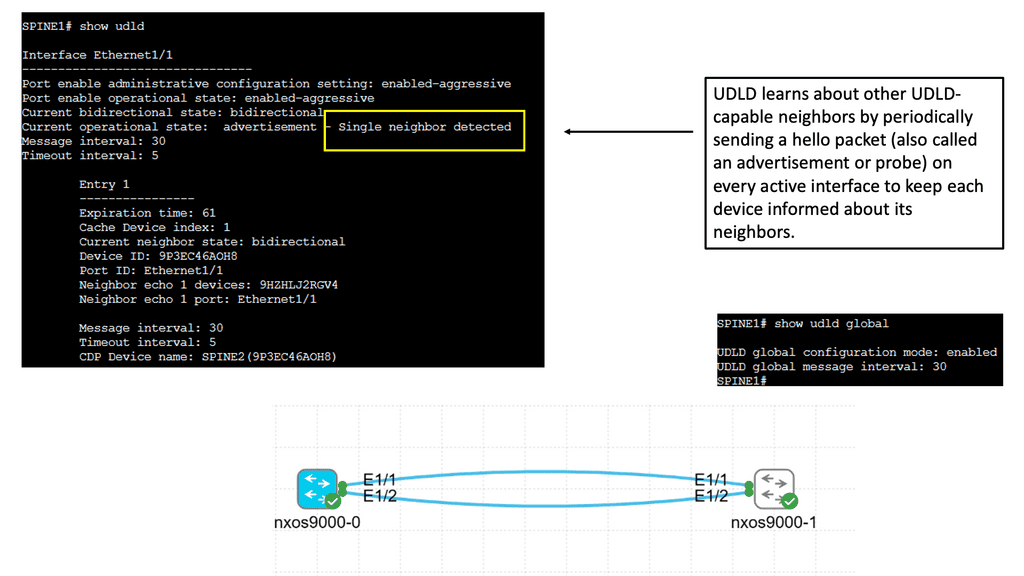
Network administrators can implement various strategies to improve routing convergence. One approach is to utilize route summarization, which reduces the number of routes advertised and processed by routers. This helps minimize the impact of changes in specific network segments on overall convergence time.
Furthermore, implementing fast link failure detection mechanisms, such as Bidirectional Forwarding Detection (BFD), can significantly reduce convergence time. BFD allows routers to quickly detect link failures and trigger immediate updates to routing tables, ensuring faster convergence.
Factors Influencing Routing Convergence
Several factors impact routing convergence in a network. Firstly, the efficiency of the routing protocols being used plays a crucial role. Protocols such as OSPF (Open Shortest Path First) and EIGRP (Enhanced Interior Gateway Routing Protocol) are designed to facilitate fast convergence by quickly adapting to network changes.
Additionally, network topology and scale can affect routing convergence. Large networks with complex topologies may require more time for routers to converge due to the increased number of routes and potential link failures. Network administrators must carefully design and optimize the network architecture to minimize convergence time.
Control and data plane
When considering routing convergence with forwarding routing protocols, we must first highlight that a networking device is tasked with two planes of operation—the control plane and the data plane. The job of the data plane is to switch traffic across the router’s interfaces as fast as possible, i.e., move packets. The control plane has the more complex operation of putting together and creating the controls so the data plane can operate efficiently. How these two planes interact will affect network convergence time.
The network’s control plane finds the best path for routing convergence from any source to any network destination. For quick convergence routing, it must react quickly and dynamically to changes in the network, both on the LAN and on the WAN.
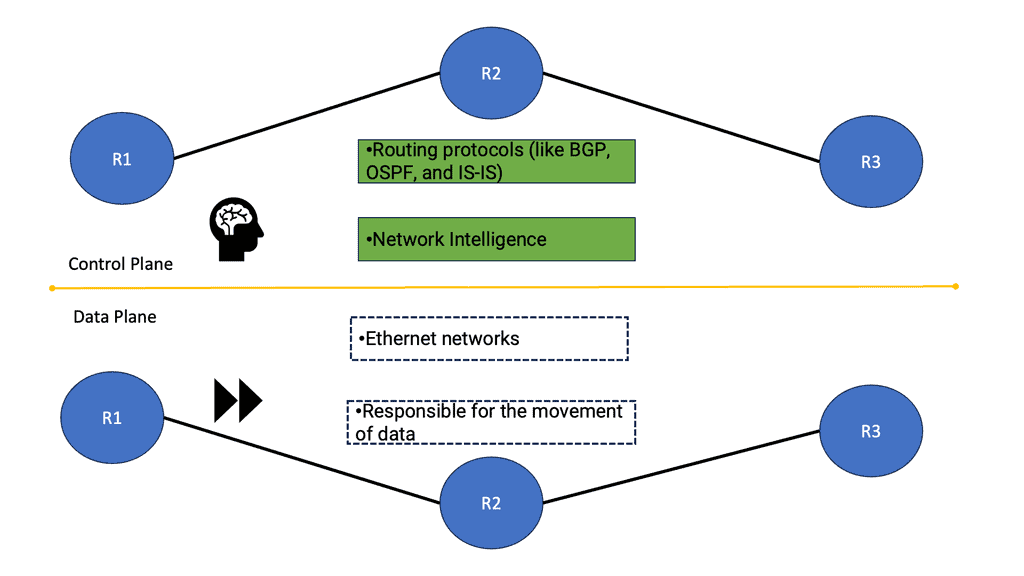
Monitoring and Troubleshooting Routing Convergence
Network administrators must monitor routing convergence to identify and promptly address potential issues. Network management tools, such as SNMP (Simple Network Management Protocol) and NetFlow analysis, can provide valuable insights into routing convergence performance, including convergence time, route flapping, and stability.
When troubleshooting routing convergence problems, administrators should carefully analyze routing table updates, link state information, and routing protocol logs. This information can help pinpoint the root cause of convergence delays or inconsistencies, allowing for targeted remediation.
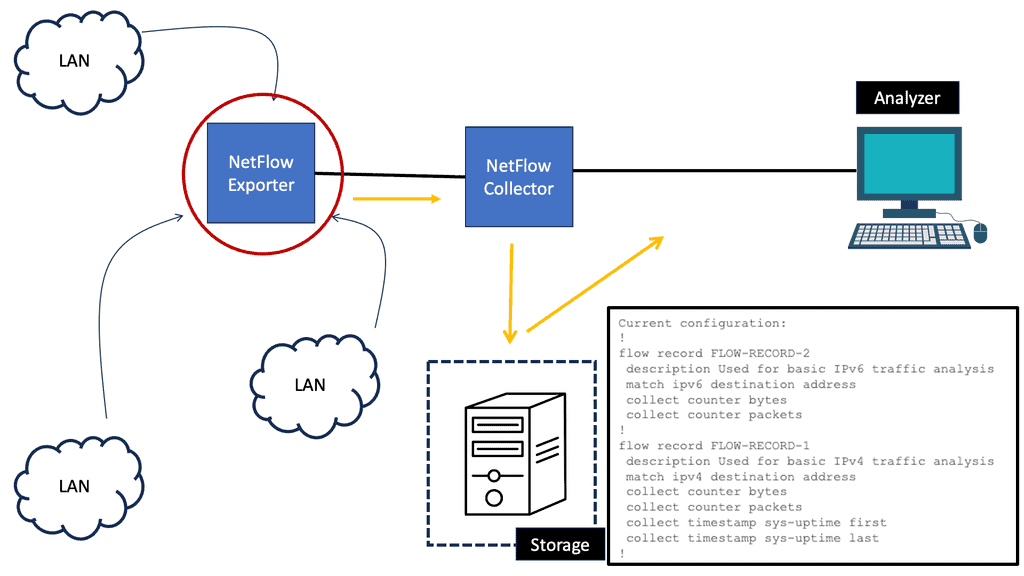
Related: For pre-information, you may find the following posts helpful: